Artificial Intelligence (AI) has revolutionized the modern world, driving technological advancements across industries. Among the cutting-edge developments in AI, Large Language Models (LLMs) and Generative AI have emerged as transformative technologies. While both belong to the broader realm of AI, their functionalities, applications, and contributions differ significantly. Understanding the difference between LLM and Generative AI provides valuable insights into their unique roles and potential impact.
What Are Large Language Models (LLMs)?
Large Language Models are AI systems designed to understand and generate human-like text. Built using neural networks, LLMs are trained on extensive datasets containing diverse text sources, enabling them to perform complex language-related tasks with remarkable accuracy.
Key Features of LLMs
- Language Proficiency: LLMs excel in comprehending linguistic nuances and generating contextually relevant text.
- Context Awareness: These models maintain coherence and logical flow in conversations and documents.
- Versatility: LLMs support a wide range of applications, from drafting emails to summarizing lengthy documents.
Applications of LLMs
- Chatbots and Virtual Assistants: Powering conversational AI tools for customer service and user interaction.
- Text Summarization: Condensing articles, reports, and research papers into concise summaries.
- Language Translation: Facilitating real-time translations between multiple languages.
- Educational Assistance: Offering detailed explanations, answers, and research support.
What Is Generative AI?
Generative AI focuses on creating new and original content, ranging from text and images to music and videos. Unlike LLMs, which primarily deal with text, Generative AI encompasses a broader range of creative outputs, simulating human innovation.
Key Features of Generative AI
- Content Creation: Generates unique outputs, such as artwork, music, and 3D models.
- Multimodal Capabilities: Integrates text, images, and audio for dynamic applications.
- Adaptive Innovation: Simulates creativity by learning patterns from diverse datasets.
Applications of Generative AI
- Digital Art: Tools like DALL-E and Stable Diffusion create stunning visuals based on textual prompts.
- Entertainment Industry: AI assists in generating scripts, animations, and visual effects.
- Product Design: Prototypes and design concepts are created with precision and efficiency.
- Music Composition: AI generates original compositions tailored to specific themes or moods.
Key Differences Between LLMs and Generative AI
While LLMs and Generative AI share a foundation in AI technology, their focus areas and applications diverge significantly:
1. Scope of Functionality
- LLMs: Primarily focused on understanding and generating text.
- Generative AI: Broader in scope, producing diverse outputs beyond text, including visuals and audio.
2. Training Data
- LLMs: Trained on large text-based datasets.
- Generative AI: Utilizes diverse datasets, combining text, images, and audio.
3. Output Diversity
- LLMs: Generates text-based outputs such as summaries, translations, and conversations.
- Generative AI: Creates content in multiple formats, such as digital art, music, and videos.
4. Applications
- LLMs: Ideal for communication, education, and research.
- Generative AI: Best suited for creative industries, design, and multimedia production.
The Benefits of Advanced AI Technologies
Advantages of LLMs
- Enhanced Communication: Facilitates seamless human-machine interactions.
- Efficiency: Automates repetitive text-based tasks, saving time and effort.
- Global Reach: Breaks down language barriers through advanced translation capabilities.
Advantages of Generative AI
- Creative Empowerment: Inspires innovation in art, design, and entertainment.
- Cost Efficiency: Reduces dependency on human labor for content creation.
- Diverse Applications: Produces unique and engaging content across various formats.
Challenges in AI Implementation
Despite their transformative potential, LLMs and Generative AI face certain challenges:
1. Ethical Concerns
The misuse of AI for generating deepfakes or spreading misinformation raises significant ethical issues.
2. Bias in AI Models
Training data biases can result in skewed outputs, impacting the fairness and accuracy of AI systems.
3. Data Privacy
AI models require extensive data for training, leading to concerns about user privacy and data security.
4. Resource Intensity
The development and deployment of advanced AI technologies demand substantial computational resources and energy.
The Future of LLMs and Generative AI
The evolution of AI technologies promises exciting advancements in both LLMs and Generative AI. Future trends include:
- Multimodal AI Models: Integrating multiple data types for comprehensive applications.
- Explainable AI: Improving transparency in AI decision-making processes.
- Energy Efficiency: Developing sustainable AI models with reduced environmental impact.
- Collaborative Tools: Enhancing human creativity and productivity through AI-assisted solutions.
Conclusion
LLMs and Generative AI represent two distinct yet complementary branches of AI technology, each playing a crucial role in advancing industries and enhancing human capabilities. While the difference between LLM and Generative AI highlights their unique applications and outputs, their collective potential lies in their ability to address complex challenges and inspire innovation.
By addressing challenges such as bias, data privacy, and ethical concerns, we can unlock the full potential of these technologies. As AI continues to evolve, its integration into various domains promises a future where human creativity and technological innovation thrive together, shaping a smarter and more connected world.
 Meet Ups
Meet Ups
 Experiences
Experiences
 Learning Center
Learning Center
 Accommodation
Accommodation
 Roomie
Roomie
 Ride
Ride
 Spread the Word
Spread the Word
 Student Bazaar
Student Bazaar
 Jobs
Jobs
 Blogs
Blogs
 حول StudentInsta
حول StudentInsta

